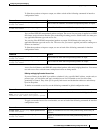
Configuring Transparent Bridging
Transparent and SRT Bridging Configuration Task List
BC-43
Cisco IOS Bridging and IBM Networking Configuration Guide
All interfaces in the bridge group that are bridging IP should have the same IP address. However, if you
have more than one bridge group, each bridge group should have its own IP address.
Enabling Autonomous Bridging
Normally, bridging takes place on the processor card at the interrupt level. When autonomous bridging
is enabled, bridging takes place entirely on the ciscoBus2 controller, significantly improving
performance. Autonomous bridging is a high-speed switching feature that allows bridged traffic to be
forwarded and flooded on the ciscoBus2 controller between resident interfaces. If you are using the
ciscoBus2 controller, you can maximize performance by enabling autonomous bridging on the following
ciscoBus2 interfaces:
• MEC
• FCIT transparent
• HSSI HDLC
Although performance improvements will be seen most in the resident interfaces, the autonomous
bridging feature can also be used in bridge groups that include interfaces that are not on the ciscoBus2
controller. These interfaces include the CTR, FCI with encapsulation bridging, and HSSI with
encapsulation other than HDLC, such as X.25, Frame Relay, or SMDS, MCI, STR, or SBE16.
If you enable autonomous bridging for a bridge group that includes a combination of interfaces that are
resident on the ciscoBus2 controller and some that are not, the ciscoBus2 controller forwards only
packets between resident interfaces. Forwarding between nonresident and resident interfaces is done in
either the fast or process paths. Flooding between resident interfaces is done by the ciscoBus2 controller.
Flooding between nonresident interfaces is done conventionally. If a packet is forwarded from a
nonresident to a resident interface, the packet is conventionally forwarded. If packets are flooded from
a nonresident interface to a resident interface, the packet is autonomously flooded.
To enable autonomous bridging on a per-interface basis, use the following command in interface
configuration mode:
Note You can filter by MAC-layer address on an interface only when autonomous bridging is
enabled on that interface. If any filters or priority queuing is configured, autonomous
bridging is automatically disabled.
Configuring LAT Compression
The local-area transport (LAT) protocol used by Digital and Digital-compatible terminal servers is one
of the common protocols that lacks a well-defined network layer (Layer 3) and so always must be
bridged.
Command Purpose
no ip routing
Disables IP routing.
ip routing
Enables IP routing.
Command Purpose
bridge-group bridge-group cbus-bridging
Enables autonomous bridging (if using the ciscoBus2 controller).


















